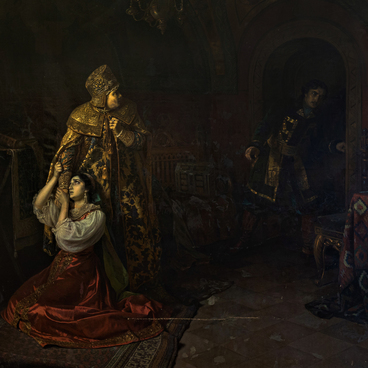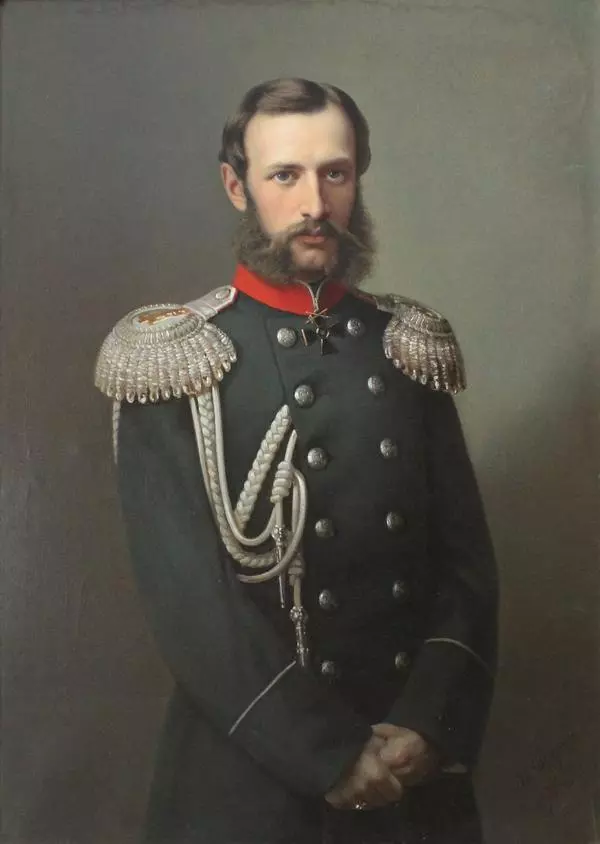The portrait painted by Ivan Tyurin depicts state official Mikhail Galkin-Vraskoy. In 1870–1879, he was governor of Saratov and an honorary citizen of Saratov, Volsk, and all the uyezd towns of the governorate.
Mikhail Galkin-Vraskoy was born on September 17, 1832, in the Kazan province. His father was Nikolay Galkin, the principal of the First Kazan male gymnasium, and his mother was a noblewoman Nadezhda Vraskaya, who petitioned Emperor Alexander II for the right of children to take a double surname.
Galkin-Vraskoy was educated at home and then took a course at Kazan University. He began serving as an official in the diplomatic service of the Orenburg and Samara governor-general. In June 1862, due to the illness of his wife, Galkin-Vraskoy was forced to go abroad for a long vacation, where he studied the prison business.
In the fall of 1870, Galkin-Vraskoy was appointed governor of Saratov and remained in this position until April 23, 1879. During this time, gas lamps, many parks, and boulevards were organized in the town, and the wooden water pipes were replaced by cast-iron ones. A river yacht club, the first winter river rescue station in Russia, a gymnasium and three colleges — Realschule, craft, and religious — were opened, as well as a branch of the Russian Musical Society. A few more colleges and schools were founded in the uyezds.
At his expense, Galkin-Vraskoy built a building for the orphanage and nursery school adjacent to it. At the governor’s initiative, two hospitals, newspapers “Saratov Diary” and “Saratov Exchange” and a penal colony for juvenile delinquents were organized.
Galkin-Vraskoy did not leave Saratov even after he had stopped being governor. He helped open the town’s university in 1909 and donated his library of eight thousand volumes to it. After the death of the official in 1916, according to his will, the Radishchev Museum received a collection of artistic treasures of almost 200 items, which Galkin-Vraskoy had been collecting all his life, and the Saratov Scientific Archive Commission was given the governor’s personal archive.
The artist Ivan Tyurin, who created this portrait, was born in 1824 in the village of Galyadkin in the Nizhny Novgorod governorate. He received a general education in a gymnasium in Moscow and from 1845 to 1850 was a non-degree student at the Saint Petersburg Imperial Academy of Arts. In 1850, Tyurin received the title of a classed artist and remained to work in St. Petersburg.
At first, Tyurin painted many landscapes and genre paintings, but soon he devoted himself entirely to portraits. In 1861, he received the title of Academician of the Imperial Academy of Arts, and with the title came new orders. Tyurin was a master of ceremonial and formal portraits, but in addition to these, he also painted icons. His works are currently housed by the Russian Museum, the State Museum of the History of St. Petersburg, and other cultural institutions.
Mikhail Galkin-Vraskoy was born on September 17, 1832, in the Kazan province. His father was Nikolay Galkin, the principal of the First Kazan male gymnasium, and his mother was a noblewoman Nadezhda Vraskaya, who petitioned Emperor Alexander II for the right of children to take a double surname.
Galkin-Vraskoy was educated at home and then took a course at Kazan University. He began serving as an official in the diplomatic service of the Orenburg and Samara governor-general. In June 1862, due to the illness of his wife, Galkin-Vraskoy was forced to go abroad for a long vacation, where he studied the prison business.
In the fall of 1870, Galkin-Vraskoy was appointed governor of Saratov and remained in this position until April 23, 1879. During this time, gas lamps, many parks, and boulevards were organized in the town, and the wooden water pipes were replaced by cast-iron ones. A river yacht club, the first winter river rescue station in Russia, a gymnasium and three colleges — Realschule, craft, and religious — were opened, as well as a branch of the Russian Musical Society. A few more colleges and schools were founded in the uyezds.
At his expense, Galkin-Vraskoy built a building for the orphanage and nursery school adjacent to it. At the governor’s initiative, two hospitals, newspapers “Saratov Diary” and “Saratov Exchange” and a penal colony for juvenile delinquents were organized.
Galkin-Vraskoy did not leave Saratov even after he had stopped being governor. He helped open the town’s university in 1909 and donated his library of eight thousand volumes to it. After the death of the official in 1916, according to his will, the Radishchev Museum received a collection of artistic treasures of almost 200 items, which Galkin-Vraskoy had been collecting all his life, and the Saratov Scientific Archive Commission was given the governor’s personal archive.
The artist Ivan Tyurin, who created this portrait, was born in 1824 in the village of Galyadkin in the Nizhny Novgorod governorate. He received a general education in a gymnasium in Moscow and from 1845 to 1850 was a non-degree student at the Saint Petersburg Imperial Academy of Arts. In 1850, Tyurin received the title of a classed artist and remained to work in St. Petersburg.
At first, Tyurin painted many landscapes and genre paintings, but soon he devoted himself entirely to portraits. In 1861, he received the title of Academician of the Imperial Academy of Arts, and with the title came new orders. Tyurin was a master of ceremonial and formal portraits, but in addition to these, he also painted icons. His works are currently housed by the Russian Museum, the State Museum of the History of St. Petersburg, and other cultural institutions.




